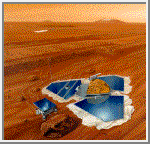
NASA Mars Probe
Courtesy of NASA's National Space Science Data Center
| Related Information |
|
Mars Pathfinder Mission Mars Pathfinder Rover Water History, Rock Composition Mars Introduction The Surface of Mars History of Space Exploration |
On-orbit dry mass: 463.00 kg
Nominal Power Output: 35.00 W
Introduction
The Mars Pathfinder was the second of NASA's low-cost planetary Discovery missions to be launched. The mission consists of a stationary lander and a surface rover. The mission had the primary objective of demonstrating the feasibility of low-cost landings on and exploration of the Martian surface. This objective was met by tests of communications between the rover and lander, and the lander and Earth, tests of the imaging devices and sensors, and tests of the maneuverability and systems of the rover on the surface. The scientific objectives include atmospheric entry science, long-range and close-up surface imaging, rock and soil composition and material properties experiments, and meteorology, with the general objective being to characterize the Martian environment for further exploration. (Mars Pathfinder was formerly known as the Mars Environmental Survey (MESUR) Pathfinder.)
Mars Pathfinder was launched on a Delta 7925 (a Delta II Lite launch vehicle with nine strap-on solid-rocket boosters and a Star 48 (PAM-D) third stage) at 6:58:00 UT (1:58 a.m. EST) on 4 December 1996. The spacecraft entered the Martian atmosphere on 4 July 1997 directly from its approach hyperbola at about 7300 m/s without going into orbit around the planet. The cruise stage was jettisoned 30 minutes before atmospheric entry. The lander took atmospheric measurements as it descended. The entry vehicle's heat shield slowed the craft to 400 m/s in about 160 seconds. A 12.5 meter parachute was deployed at this time, slowing the craft to about 70 m/s. The heat shield was released 20 seconds after parachute deployment, and the bridle, a 20 meter long braided Kevlar tether, deployed below the spacecraft. The lander separated from the backshell and slid down to the bottom of the bridle over about 25 seconds. At an altitude of about 1.6 kilometers, the radar altimeter acquired the ground, and about 10 seconds before landing four air bags inflated in about 0.3 seconds forming a 5.2 meter diameter protective 'ball' around the lander. Four seconds later at an altitude of 98 meters the three solid rockets, mounted in the backshell, fired to slow the descent, and about 2 seconds later the bridle was cut 21.5 meters above the ground, releasing the airbag-encased lander. The lander dropped to the ground in 3.8 seconds and impacted at 16:56:55 UT (12:56:55 p.m. EDT) on 4 July 1997 at a velocity of 18 m/s - approximately 14 m/s vertical and 12 m/s horizontal - and bounced about 12 meters (40 feet) into the air, bouncing at least another 15 times and rolling before coming to rest approximately 2.5 minutes after impact and about 1 kilometer from the initial impact site.
 After landing, the airbags deflated and were retracted. Pathfinder opened its three
metallic triangular solar panels (petals) 87 minutes after landing. The lander first
transmitted the engineering and atmospheric science data collected during entry and
landing, the first signal being received at Earth at 18:34 UT (2:34 p.m. EDT). The imaging
system obtained views of the rover and immediate surroundings and a panoramic view of the
landing area and transmitted it to Earth at 23:30 UT. After some maneuvers to clear an
airbag out of the way, ramps were deployed and the rover, stowed against one of the
petals, rolled onto the surface on 6 July at about 05:40 UT (1:40 a.m. EDT).
After landing, the airbags deflated and were retracted. Pathfinder opened its three
metallic triangular solar panels (petals) 87 minutes after landing. The lander first
transmitted the engineering and atmospheric science data collected during entry and
landing, the first signal being received at Earth at 18:34 UT (2:34 p.m. EDT). The imaging
system obtained views of the rover and immediate surroundings and a panoramic view of the
landing area and transmitted it to Earth at 23:30 UT. After some maneuvers to clear an
airbag out of the way, ramps were deployed and the rover, stowed against one of the
petals, rolled onto the surface on 6 July at about 05:40 UT (1:40 a.m. EDT).
The bulk of the lander's task was to support the rover by imaging rover operations and relaying data from the rover to Earth. The lander was also equipped with a meteorology station. Over 2.5 meters of solar cells on the lander petals, in combination with rechargeable batteries, powered the lander. The lander on-board computer is based on 32-bit architecture with 4 million bytes of static random access memory and 64 million bytes of mass memory for storing images. The main lander components are held in a tetrahedral shaped unit in the center of the three petals, with three low-gain antennas extending from three corners of the box and a camera extending up from the center on a 0.8 meter high pop-up mast. Images were taken and experiments performed by the lander and rover until 27 September 1997 when communications were lost for unknown reasons.
The landing site in the Ares Vallis region of Mars is at 19.33 N, 33.55 W. The lander has been named the Sagan Memorial Station. The Ares Vallis region of Mars is a large outwash plain near Chryse Planitia. This region is one of the largest outflow channels on Mars, the result of a huge flood (possibly an amount of water equivalent to the volume of all five Great Lakes) over a short period of time flowing into the martian northern lowlands.
The Mars Pathfinder mission cost approximately $265 million including launch and operations. Development and construction of the lander cost $150 million and the rover about $25 million.

 Space History
Space History